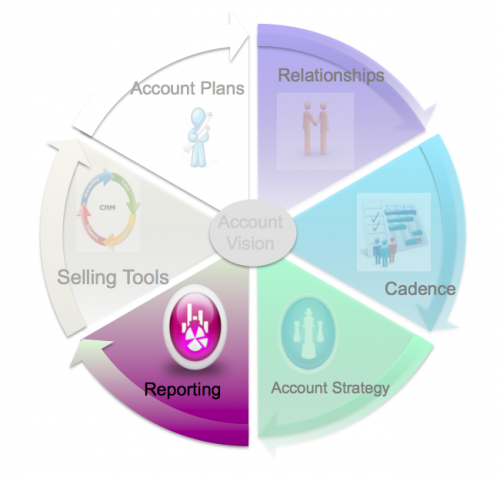This is part 7 of an 8 part series on Account Governance
A saying of a good friend of mine is “we’re at the blunt end of the stick” and when it comes to sales he’s right. Sales is on the tip of the spear when it comes to the company. They have the relationships with the customers. Sales has access to what is going on. Sales is responsible for making the revenue happen.
Knowing this, sales owes it to the organization and to themselves to communicate what is going on. To keep the company informed and abreast of what is happening sales needs to deliver robust, simple, reporting schemes to the organization.
When it comes to reporting, I don’t think there is one size fits all. However, there is certain information every company needs to track. The baseline sales data that needs to be collected, and believe it or not ISN’T in all companies, is funnel or pipeline data, closed business, and revenue.
Beyond the baseline data every sales person and company needs to have their own set of metrics and reporting.
To build a good reporting structure it’s important to know what you want to measure. Far too often sales organization measure the same things; revenue, profit or gross margin, and funnel. As I said earlier these are must haves. But, sales organizations need to go further. Good account governance adds it’s own set of KPI’s (Key Performance Indicators) to the standard metrics.
Choosing what to measure will be specific to each account and each sales organization.
KPI’s I’ve found valuable in the past:
Wallet-Share
Forecast/Outlook
Key Programs
Competitive Wins
New Product Wins
Losses
Product % of revenue (what % of revenue comes from what products)
Key Deals
Dependencies (things the sales team depends on to make or close a deal that another functional group is responsible for)
Linearity (the consistency of sales, does sales come in evenly or in major swings?)
Forecast accuracy (does the team actually meet their stated forecast goals, what is the % of forecast accuracy?)
Net New Customers
Lost Customers
Upgrades
Customer Satisfaction
Demo’s
When it comes to reporting the thing to walk away with is; it’s extremely important to identify the critical components of your sales environment and business and report on them. Build a dashboard that allows a quick snapshot of where you are. This should be done at the management level as well as the account level. The most successful account managers I’ve seen create their own account dashboard and KPI’s. They act as a guide, a benchmark, allowing management and account managers to see where they are going and what needs to be addressed. It allows for proactive management.
In addition to a dashboard and KPI’s, there is an internal reporting cadence that is a must have. It’s the quarterly business review or account review. To me there is only one way to execute a QBR. Each member of the team has 3 hours each quarter to update the entire team on what they said they would do, what they did, what they didn’t do, what they learned and what they will do next quarter. This approach to quarterly business/account review drives tremendous accountability into the process. Traditionally, QBR’s waste everyones time while the presenters regurgitate the same old information of what they did, regardless of whether or not it’s what they said they were going to do, they avoid calling out failures, or missteps, they don’t address what they will do moving forward etc. Traditional QBR’s lack accountability. I make them as simple and straight forward as possible. We only address what it is we said we were going to do, what were our goals and objectives, did we make them or not. Why? Where does that leave us? Can we make up the losses? If so, how? What are we going to do different? How do we know that’s going to work? What are next quarters goals and objectives? etc. The QBR’s are solely focused around the goals, initiatives, and tactics committed to at the beginning of the quarter.
Reporting is two things, what is being reported, (the information) and how it’s being reported, (the cadence.) Successful sales teams and account teams pick the right things to measure and have an internal reporting cadence of accountability. It’s that simple.
Previous Posts in the series:
Part 1: Account Governance - [The Ultimate Sales Process]
Part 2: Account Governance - [Vision]
Part 3: Account Governance - [Account Plans]
Part 4: Account Governance - [Relationships]

